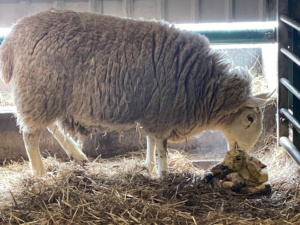As ewes approach lambing, their requirement for protein increases by almost 50%. This increase is necessary to sustain her needs for maintenance, pregnancy, udder formation and colostrum production. Metabolisable Protein (MP) is the protein that is used by the ewe for these processes. A shortage of MP will result in poorer colostrum production and reduced lamb survival. This is a different measure to Crude Protein (CP).
CP is a measure of total protein supply and includes some protein which cannot be utilised by the ewe. MP is the total protein available for the ewe to use and it is a combination of protein made in the rumen, by the rumen microbes (known as MCP*) and protein that bypasses the rumen (known as DUP*).
MCP is synthesised in rumen by the rumen microbes which rely on a good balance of rumen available energy and protein in the diet. MCP is the most significant source of amino acids to the ewe. If either energy or protein is limiting in the ewe’s diet, this reduces her ability to make MCP and as a result she will be short of overall MP. A good balance of energy and protein in the rumen = more useful protein for the ewe and reduced potential emissions.
*MCP = Microbial Protein and DUP = Digestible Undegraded Protein
The Metabolisable Protein (MP) System
The metabolisable protein system was introduced to ensure that ruminant diets supply optimal levels of usable protein for the animal. Ruminants are unique in their capacity to use poor quality protein sources in the form of forage and make a high quality protein source in the form of MCP using their rumen microbes. However, to optimise this production the ruminant demands a well balanced ration with even levels to fermentable metabolisable energy (FME) and effective rumen degradable protein (ERDP). If one is lacking the MP supply is only as effective as the 1st limiting factor with a cost to the overall production of the animal.
- If ERDP is limited below requirements and FME is in excess ⇒ reduced intakes and digestion.
- If FME is limited and ERDP is in excess ⇒ elevated ammonia levels in blood excreted as urea = WASTE
In order to reduce inefficiency, optimise protein supply and reduce waste we are aiming for a well balanced diet with ERDP supply equal to FME supply which is and ERDP:FME ratio of 1:10
THE PERFECT 10!
The main component of any pre-lambing ration is forage (grazed grass, silages or hay) it is important we first focus on the balance of forage and supplement any deficiencies thereafter.
Protein from Forage
The table below shows the balance of protein and energy in the forage can make a big impact, to the overall MP supply of the ration irrespective of the total protein and energy in the forage. To balance these forages the deficit should be made up with a source high in the limiting factor. A source of DUP is also important to make up the deficit in pregnancy when MCP optimised, limited or when ewes are lean.
| Predicted DMI (kg DM / day) (70kg twin 2wks pre-lambing) | ERDP:FME | 1st Limiting
Factor |
Predicted ME
Supply from forage (g/day) |
% of total MP
requirement from forage |
|
| Average Hay (8.5ME, 9% CP) | 0.77kg | 6.5 | Protein | 45g | 37.8% |
| Good Silage (12 ME, 14% CP) | 1.19kg | 11.5 | Energy | 84g | 70.6% |
| Silage (11.5ME. 12.5% CP) | 1.19kg | 10 | – | 86g | 72.3% |
| Silage (9 ME, 11% CP) | 0.84kg | 12.3 | Energy | 45g | 37.8% |
Supplementation options
| ERDP | FME | DUP |
| Rapeseed meal | Cereals (maize, barley, wheat, oats) | Soya bean meal |
| Distillers grains (not from copper stills) | Distillers grains (not from copper stills) | Rumen protected soya |
| Beans / peas | Beans | Rumen protected rapeseed meal |
| Root crops | ||
| Molasses |
Key points
Optimum protein supplementation of the ewe is reliant on a number of factors, primarily the supply of both protein and energy in the ration and the optimum functioning of the rumen. If the ration is deficient in either protein or energy, the ruminant will struggle to synthesise sufficient levels of microbial protein, to meet requirements, resulting in losses to production or waste of nutrients that cannot be utilised resulting in inefficiencies of protein use. This will also result in a higher demand for additional supplementation above forage which can come at a cost.
- MP requirements increase by 50% in late pregnancy.
- The ewe is reliant on a diet balanced in rumen available energy and protein and topped up with a source of DUP to meet these increased MP requirements.
- An imbalance in the ration can lead reduced intakes, decreased nutrient availability or waste of nutrients that comes at a cost to the animal and environment.
- Analysing forage is the first step to formulating a balanced ration from there we can assess which feed best compliments the forage to meet the requirements of the ewe.


